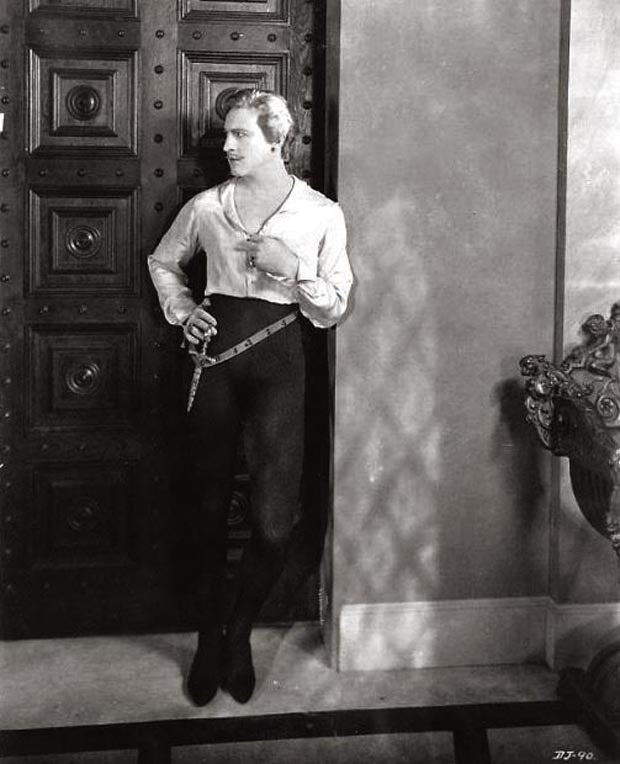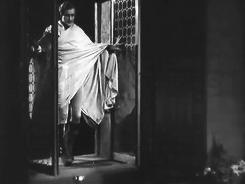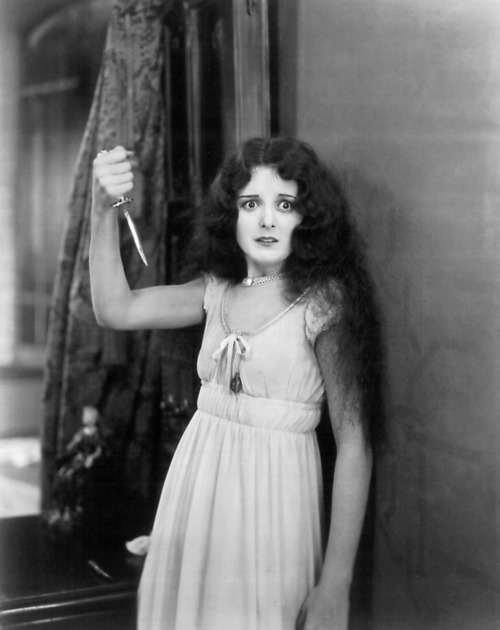A sinopse do IMDb é simples, direta e engraçada: “o mulherengo misógino
Don Juan se apaixona por garota do convento”. O papel do famoso Don Juan fica
por conta do excelente John Barrymore, em um filme de 1926 que estava destinado
a entrar para a história graças a uma ousadia pontual da Warner Brothers.
The
IMDb synopse is simple, direct and laughable: “Misogynistic skirt chaser Don
Juan falls for convent girl”. The role of famous womanizer Don Juan is played
by brilliant John Barrymore in a 1926 film that made history because of a
daring technological move from Warner Brothers.
A fama de conquistador de Don Juan vem de… um trauma de infância.
Juanzito viu seu pai, Don José (também interpretado por John Barrymore)
expulsar a mãe infiel de casa. Depois disso, Don José tomou gosto por orgias,
até ser morto por uma de suas amantes ciumentas. Suas últimas palavras para o
filho? “Conquiste o amor das mulheres pelo mundo, depois sorria e as esqueça”.
Don
Juan's fame came from... a childhood trauma. Juanzito saw his father, Don Jose
(also played by John Barrymore) kicking his unfaithful mother out of the house.
Then Don Jose started hosting orgies, and finally was killed by one of his
jealous lovers. His last words to his son? “This is my legacy to you – beware
of giving your love to women. Go out into the world and take their love when it
please you – smile – and forget!”
Ele segue o conselho à risca, colecionando conquistas em seu belo castelo
na Espanha. Sua fama chega aos ouvidos de Lucrécia Bórgia (Estelle Taylor), que
o convida para uma festa no palácio dos Bórgia. Curioso, ele vai à festa, e lá
se apaixona por Adriana della Varnese (Mary Astor), uma jovem noviça que é
também filha de um inimigo político dos Bórgia.
He follows dad's advice and has a collection
of conquests in his veutiful castle in Spain. His reputation becomes known to
Lucrezia Borgia (Estelle Taylor), who invites him to a party at the Borgia
palace. He gets curious and decides to attend the party. There he falls in love
with Adriana della Varnese (Mary Astor), a young convent girl who is also the
daughter of a political enemy of the Borgias.
John Barrymore, atlético de legging, é sedutor, mas falta algo
para ser o amante latino perfeito. Durante todo o tempo me lembrei de Douglas
Fairbanks, que um ano antes também seduziu Mary Astor em “O Filho do Zorro”.
John traz dramaticidade ao papel de Don Juan, mas se Douglas estivesse em seu
lugar, haveria mais carisma e aventura. Seria mais fácil torcer para Don Juan
se ele fosse interpretado por Douglas Fairbanks. Com John, ele é um babaca que
de repente muda ao se apaixonar. Difícil
de acreditar nisso.
John
Barrymore, athletic in his leggings, is seductive, but there is something
missing for him to be the perfect Latin lover. During all the film I was
thinking about Douglas Fairbanks, who, in the previous year, also seduced Mary Astor in “Don Q Son of Zorro”. John brings drama to his Don Juan, but if
Douglas was in his place, ther would be more charisma and adventure. It'd be
easier to root for Don Juan if he was played by Douglas Fairbanks. With John,
he is a womanizer who suddenly changes when he falls in love. It's hard to believe in it.
Os cenários são realmente deslumbrantes. Outro destaque curioso é a dama
de companhia de Lucrécia, Mai, interpretada por Myrna Loy. O irmão Cesare
Bórgia é interpretado por Warner Oland, ator sueco que na década seguinte
interpretaria o detetive Charlie Chan.
The
sets are breathtaking. Someone to keep your eyes on is Lucrezia’s
lady-in-waiting, Mai, who is played by Myrna Loy. Lucrezia’s brother, Cesare
Borgia, is played by Warner Oland, a Swedish actor who would play Charlie Chan
in the 1930s.
Existe química entre John Barrymore e Mary Astor? Bem, eu diria que há
mais medo por parte de Adriana, que é a personificação perfeita da donzela indefesa,
e uma obsessão não necessariamente saudável por parte de Don Juan. Mas John e
Mary já eram velhos conhecidos: John foi o primeiro amor de Mary, quando ela tinha
17 anos e ele, 42. Eles se conheceram nas gravações de “Beau Brummel” (1924) e
tiveram uma relação conturbada, impedida pela vigia constante dos pais de Mary,
que estavam mais preocupados com a fonte de renda que com a felicidade da
filha.
Is
there chemistry between John Barrymore and Mary Astor? Well, I’d say that Adriana
shows more fear than passion, making her the perfect personification of the
damsel in distress. Don Juan, on the other hand, shows a not very healthy
obsession with the lady. But John and Mary were old acquaintances: John was
Mary’s first love, when she was 17 and he was 42 years old. They met while doing
“Beau Brummel” (1924) and had a difficult relationship that wasn’t consummated because
Mary’s parents were always after her. Great parenting? Not really, because they
were more concerned with the loss of her career than with her happiness.
Foi Barrymore que quis contracenar com Astor em “Beau Brummel”. Dois anos
depois, ele quis trabalhar novamente com ela, mas a atriz escalada para “The
Sea Beast” foi Dolores Costello, por quem John também se apaixonou, desta vez,
perdidamente. Ele até tentou que Dolores fosse contratada para interpretar
Adriana em Don Juan, mas a quadrilha amorosa voltou ao começo com Mary Astor
sendo a escolhida – e trabalhando com bastante tristeza.
It
was Barrymore who wanted to work with Astor in “Beau Brummel”. Two years later,
he wanted her again as his leading lady, but Dolores Costello was cast. John
also fell in love with Dolores, and stated “That time I knew I was right”. He
even tried to secure Dolores the role of Adriana in Don Juan, but the love
story went full circle with Mary Astor being cast – and going to work heartbroken.
Don Juan merece um lugar nos livros de história do cinema porque foi o
primeiro passo para a Warner revolucionar o mundo cinematográfico. Don Juan foi
o primeiro filme com som sincronizado através do sistema Vitaphone, idealizado
pela Warner e que no ano seguinte evoluiria para o primeiro filme com diálogos,
“O Cantor de Jazz”, este sim o grande revolucionário. O Vitaphone acabou sendo
abandonado pela Warner quando outro sistema, o Movietone da MGM, se mostrou
superior para gravar áudio sincronizado, mas sem o Vitaphone o som demoraria um
pouquinho mais para chegar ao cinema.
Don Juan deserves a place in film history
books because it was the first step for Warner to revolutionize the film world.
Don Juan was the first film released with a synchronized soundtrack due to the
Vitaphone system, created by Warner and then developed to make the first film
with spoken dialog the following year, “The Jazz Singer”. Vitaphone was
abandoned by Warner when another system, MGM's Movietone, was considered
superior at recording synchronized audio. But, without Vitaphone, sound would
take a little longer to arrive at the movies.
Carismático e fazendo suas cenas sem dublê,
Barrymore é um dos destaques do filme (além da presença sempre luminosa de
Myrna, claro). Ele também foi um homem muito conquistador, embora sua
trajetória tenha sido bem menos heroica. Ora, Barrymore foi, à sua maneira, um
Don Juan, e sua redenção veio com seu maior talento: o de atuar.
Charismatic and doing his
own stunts, Barrymore is one of the highlights in the film (besides Myrna’s
luminous presence, of course). He was also a man of several women, although his
life was much less heroic. Well, Barrymore was, in his own way, a Don Juan, and
his redemption didn’t come from a woman, but from his greatest talent: acting.
This is my contribution to
the Second Annual Barrymore Trilogy blogathon, hosted by Crystal at In the Good
Old Days of Classic Hollywood.







6 comments:
ah, esse não vi. essa história é clássica. amei as imagens. eu só vi outra mais recente. beijos, pedrita
Beautiful post, thank you for translating in both English AND Español!!
John Barrymore was stunningly handsome, and I forgot how gorgeous Mary Astor was in her youth. Looks like they had great chemistry, too, even though he really wanted Dolores as his leading lady.
I need to see this one! Silents were ultra-stylish and beautifully composed...the black-and-white photography is shimmering and silvery...
-Chris
Wow! Check out that long hair on Astor!! I haven't seen very many John Barrymore films - I have seen his silent Sherlock but only because it was William Powell's first film. Great post and good point about Fairbanks!
Hey Le. Excellent post. As much as I love John Barrymore, you do make a good point about Douglas Fairbanks. Thanks so much for joining in on the blogathon.
Don't forget to check out my contribution to the blogathon
https://crystalkalyana.wordpress.com/2016/08/20/the-secret-of-convict-lake-1951/
Parabens! Nice work!
Fascinating review! I really enjoyed Myrna Loy in this one, too - I always like Mary Astor, but in this one I thought it would have been fun to have even more Myrna Loy!
I also wanted to invite you to participate in a blogathon I'm co-hosting. It's called Characters in Costume and it's about the costumes, makeup, etc of the characters in film.
https://christinawehner.wordpress.com/2016/09/07/announcing-the-characters-in-costume-blogfest-fiction-and-film/
Post a Comment